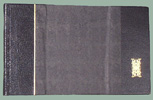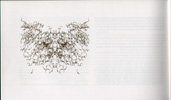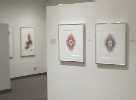< galleries & projects | main menu | site map | search | contact
ALGORITHMIC ART
T W E N T Y Y E A R S
Arizona State University at Tempe, AZ
Computing Commons Gallery
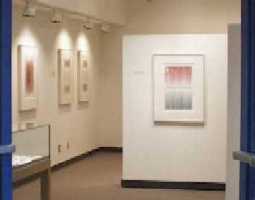
January 18 to March 9, 2001
ROMAN VEROSTKO. This show represents twenty years of experimental work writing detailed instructions coded to drive pen plotters that are drawing machines designed for architects & engineers. Instructions (algorithms), created by the artist, control every minute detail of drawing and brushing activity. Every pen and brush stroke, in this exhibition, was executed with either a pen or a brush mounted on the drawing arm of a pen plotter working under the guidance of the artist's instructions (algorithms). Gold leaf was applied by hand with traditional materials. For more detail on studio procedures click here.EXHIBITION CATALOGUE
Pathways
1.
Pathway A. 2000
Paper Size: 29" by 23"
Pen and ink plotted drawing.
2.
Pathway B. 2000
Paper Size: 29" by 23"
Pen and ink plotted drawing.
In the works above the "all-over" distributions are linear random walks with numerous iterations. The text-like inscription is an algorithmically generated visual label.
These works were achieved with routines used in the artist's earliest pen plotted drawings. The procedures grew from his Magic Hand of Chance (1982-85), a work that drew animated linear sequences on a monitor. Prototypes of these software procedures may be found in forms of automatism practiced by some dada artists and surrealists in the early 1920's. "Automatic" writing and drawing sought to explore unconscious regions of human experience using spontaneous or non-rational methods as in making a thoughtless "doodle".
Polarities
3.
West-East 1. 2000
Paper Size: 23" by 29"
Pen and ink plotted drawing.
4.
West-East 2. 2000
Paper Size: 23" by 29"
Pen and ink plotted drawing.
Linear fields address the attraction and repulsion of opposites - their similarity and their difference are presented simultaneously as "West-East" or "Heaven and Earth". These images evoke experience that transcends the tight bounds of earth and object. The routines were developed from random distributions with parameter controllers for elements such as scale and direction.
5.
Heaven & Earth. 2000
Paper Size: 29" by 23"
Pen and ink plotted drawing.
6.
Nested Swallow. 1997
Paper Size: 42” by 30”
Brush and pen plotted drawing.
7.
Flying Crane. 1996
Paper Size: 42” by 30”
Date: 1996.
Brush and pen plotted drawing.
The artist's first robotic brush strokes were achieved in 1987. The strokes achieve spontaneous qualities using coded procedures. The software generates a brush form and requests a paint brush. The artist places a loaded brush in the plotter's drawing arm and the plotter executes the stroke. For the text-like characters a self inking sumi brush is employed much like an ink pen.
The linear character in the medallion was plotted algorithmically and identifies the controller for the brush stroke and all the pen strokes in a specific work.
Three Sisters: Gaia Improvisations
8.
Gaia E II, 1996.
Paper Size: 30" by 22"
Pen plotter drawing.
9.
Gaia E VII, 1995.
Paper Size: 30" by 22"
Pen plotter drawing.
10.
Gaia E VIII, 1995.
Paper Size: 30" by 22"
Pen plotter drawing.
Familial Resemblance. The software procedure generates a "family" of forms with a strong familial resemblance. These works resemble each other because they were generated from the same parent code, a software procedure capable of generating a series of forms that resemble each other as in a family. This work demonstrates the similarities between the artist's software and epigenesis. In this instance, somewhat as in a garden, members of the the "family" were "generated" with the artist's software. The text-like characters, derived from the same visual initiators as the central clusters, add to the "self similarity" of the whole.
11.
Diamond Lake Apocalypse, Pathway, 1993
22" by 30"
Pen plotted drawing.
12.
Diamond Lake Apocalypse, Burning Bush, 2000
23" by 29"
Pen plotted drawing.
Illuminated Algorithmic Scripts. Presented as an opened book with a page left and a page right, the work is intentionally fashioned as a "precious object" in the tradition of the illuminated manuscript. Just as the medieval monk transformed the written word through "illumination" so, in our time, with a pen plotter, an electronic sciptor, transforms algorithmic scripts into precious objects. With its network of pen plotters the artist views his studio as an electronic scriptorium where digital procedures are celebrated in the form of illuminated scriptures. The studio overlooks the Diamond Lake that inspired the title for this series.
13.
Diamond Lake Apocalypse, Canon I, 1999
23" by 29"
Pen plotted drawing.
Illuminated Universal Turing Machine
14.
Illuminated Universal Turing Machine T3, 1995
Paper Size: 30" by 22"
Pen plotted drawing on paper.
15.
Illuminated Universal Turing Machine T4, 1995
Paper Size: 30" by 22"
Pen plotted drawing on paper.
The central rectangle with a gray appearance is composed of a specific sequence of 1's and 0's. This is a "text" for one version of a Universal Turing Machine (UTM) quoted from Roger Penrose' The Emperor's New Mind (Chapter 2). The sequence of 5,495 digits expresses an algorithm, in expanded binary, for a UTM. This algorithm holds a special place in the history of computing machinery since all general computers are Universal Turing Machines. In the tradition of illuminated sacred texts this algorithm is presented as a valued authoritative text of our times. The pen plotted form enhancements, generated with the artist's code, require the logic of a UTM for execution, thus being a form of "Turing on Turing"! For examples of the artist's Turing Machine "self portraits" and further documentation on UTM's click here.
16.
Two Thousand Improvisations, v2, 2000
Paper Size: 29” by 23” Date:
Pen plotted drawing on paper.
17.
Two Thousand Improvisations, v3, 2000
Paper Size: 29” by 23”
Pen plotted drawing on paper.
These improvisations, celebrating 2000 years, were begun in 1999. Three series with various versions have been drawn. Each version presents a different series of two thousand improvisations, each individually drawn with pen and ink, line for line, without any repetitions. The detailed originals can be hypnotizing as the eye wanders from one unit to the next discovering unexpected form inventions from one rectangle to the next
18.
Cyberflower I. 3, 2000
29" by 23"
Pen plotted drawing
19.
Cyberflower IV. 1, 2000
29" by 23"
Pen plotted drawing20.
Cyberflower V. 1, 2000
29" by 23"
Pen plotted drawingSome years ago an artist colleague entered Verostko's studio and saw his algorithmic pen plots for the first time. Spontaneously and with some gusto, he exclaimed "Computer flowers!". Since then the algorists of the late 20th Century have been generating a cyber landscape with many faces . Verostko believes we have seen only the tip of a huge continent of unbelievable dimension, a marvelous world of form to be explored and enjoyed in the 21st Century. These cyberflowers, harvested from this new world, are several of his best at the turn of the Century.
The algorithm driving this series generates its curvilinear procedures from a single set of coordinates. Algorithmic improvisations based on a single set of coordinates introduce a self similarity that permeates the form on several levels.
Visions of Hildegard
21.
Visions of Hildegarde, G, 2000
29" by 23"
Pen plotted drawing.
22.
Visions of Hildegarde, L, 2000
29" by 23"
Pen plotted drawing.
Arrays of form. The pen plotted "Visions of Hildegarde" invite meditation through arrays of improvisation. Each vision, one more improvisation in the seemingly countless array of possibles, points to the manner in which the limits of the drawing procedure, like life, are unknowable.
Hildegarde of Bingen (1098-1179), a medieval theologian and mystic organized her major prophetic work, Scivias, around 26 visions divided in three parts (6,7,13). Her work includes hymns composed with chant notation that appeal to the human spirit and the search for spiritual fulfillment.
Two of Hildegard's hymns in Latin and English with links to source manuscripts with chant notation may be found at: http://www.irupert.com/HILDEGRD/hildetext.htm. For a Hildegard biographical see: http://www.newadvent.org/cathen/07351a.htm
Model of the "Growth of Form" Mural, Version III, 1:6 Scale.
23.
Epigenesis: the Growth of Form (1996-2000).
19" by 76"
Pen & brush plotted drawing.
Created as a work of art in its own right, this piece models, on a scale of 1:6, the forms and procedures employed for a pen plotted mural composed of eleven 3 foot by 6 foot units. Both this model and the finished work are pen and brush plotted drawings. The full scale project, framed with stained oak paneling, occupies a space measuring 9 feet by 40 feet at the University of St. Thomas Science and Engineering Center (St. Paul, Minnesota, 1997). This version, an algorithmic clone of the original model, was completed in September, 2000.The brush strokes and gold roundels, identify the visual theme permeating eleven improvisations. Form-generating procedures, created by the artist, employed this linear form for growing this suite of eleven graphic harmonies. Executed with a multi-pen plotter, clusters of pen strokes mirror themselves with improvisations of form based on the same information that controlled the very first line in the suite. The central geometrical figure, drawing on the same visual theme, reveals one more morphological improvisation. The eleven unit harmonic suite displays the growth of form and, by analogy to the biological term, may be viewed as epigenesis.
Model as shown in the gallery.
For details on the mural project click here.
Books from the limited edition of Boole's "Derivation of the Laws...".
24.
Text page and illustration, 1990
Open: 6" by 20"
Pen plot.Derivation of the Laws by George Boole . The "Derivation..." text is Chapter III from Boole's classic work: An Investigation of the Laws of Thought.. (Macmillan, 1854).
25.
Frontispiece, #9, 1990
Open: 6" by 20"
Brush and pen plot.
26.
Frontispiece, #82, 1990
Open: 6" by 20"
Brush and pen plot.
For this project the "tipped in" front and end pieces were pen-plotted in an algorithmic serial edition. Each drawing, "one of a kind", was drawn or brushed, stroke for stroke with a pen plotter driven by the artist's software. Two families of form, 125 originals in each, introduce a radically new procedure that Roger Malina has referred to as "post mechanical" reproduction. This form-generating procedure has already impacted the printing industry and will have a profound impact on the graphic arts in the 21st Century. This edition (1990) may be the first instance where an algorithmic improvisational series of original drawings was created for a bound limited edition.
27.
Endpiece, #14, 1990
Open: 6" by 20"
Pen plotted drawing.
28.
Endpiece, #79, 1990
Open: 6" by 20"
Pen plotted drawing.The limited edition of 125 copies, bound in leather, was pulled by hand at the St. Sebastian Press in Minneapolis in 1990. Each copy has original, "one of a kind", tipped in front and end pieces with pen and brush plotted drawings executed in the artist's studio. Other illustrations were pulled with line cut plates made from original pen plotted drawings. The work was also issued in a reproduction paperback version based on the original type setting and plotter drawings (February 1991, ISBN 1-879508-07-9). The press is no longer active. The artist retains a limited number of copies of each edition. © Roman Verostko
Gallery bookcase display (click for detail)
29.
Deluxe binding. Gold stamp device from an algorithmic pen drawing, 6" by 10", 1990.
Typography by Michael Tomaszewski; set in Gill Sans; cast by M&H Type of San Francisco. Binding by Michael Norman. Plotter drawings and brush strokes executed by Alice Wagstaff using Roman's algorithms. Pathway Studio Seal by Wang Dong Ling (Hangzhou PRC).
31.
Reproduction edition printed by Twin City Litho
Saint Sebastian Press, 1990
Ornament page, verso, 10" by 6"
Print, line cut plate from algorithmic pen drawing
For more information on this edition click here.
The Sun Canticles
31.
Canticle to the Sun II, 1996
20" by 15""
Pen plotted drawing.
32.
Canticle to the Sun IV, 1996
20" by 15""
Pen plotted drawing.
In 1966 the artist painted a large eight-foot by four-foot wooden panel as a "Canticle to the Sun". That work, celebrating the sun, incorporated text from the sun canticle by Francis of Assisi (1182-1226). Reminiscent of the same canticle, these pen plotted works celebrate the sun using radial algorithms. The artist employed radial algorithms in works dating back to 1987. The illuminated brush strokes have no rational meaning. These algorithmic brush plots display visual pathways arbitrarily chosen from a vast array of possible sequences.
![]() Some works have a studio seal. For detailed information click
here.
Some works have a studio seal. For detailed information click
here.
*Chronicle of Higher Education*, click here
Arizona Republic review by Megan Bates, click here
Koleen Robert's review in ASU's "Inside IT", click here
^
top of page | galleries
& projects
| main menu | site
map
| search | contact
Copyright Roman Verostko, 2000. All rights
reserved.
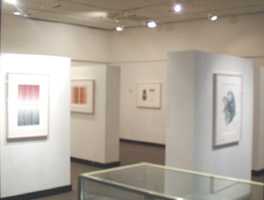


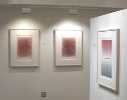

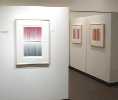


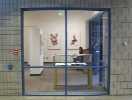
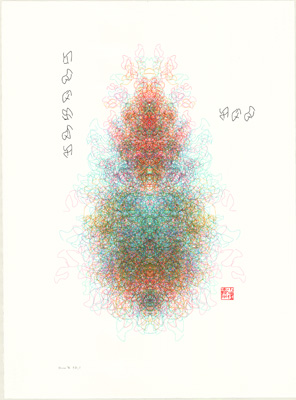
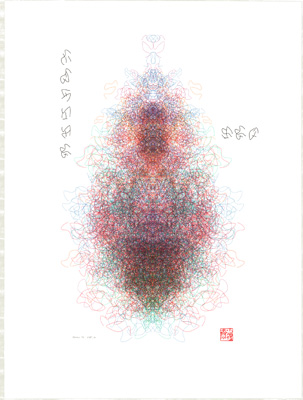
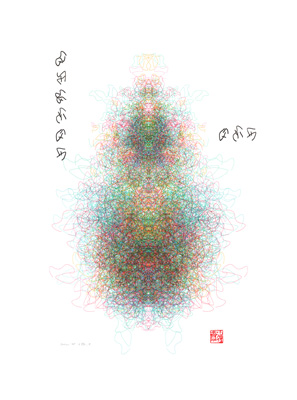



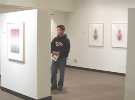


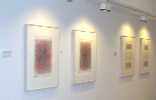


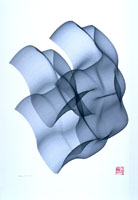
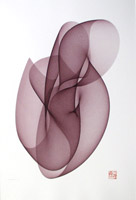
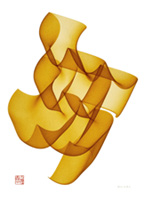
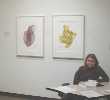


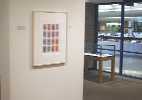 Gallery
view
Gallery
view



